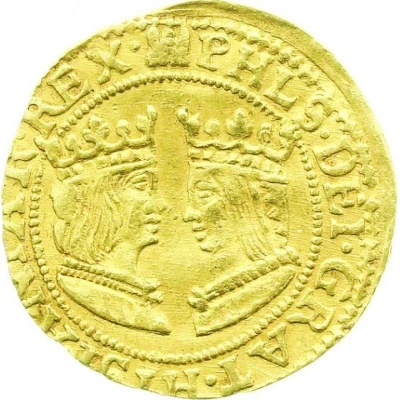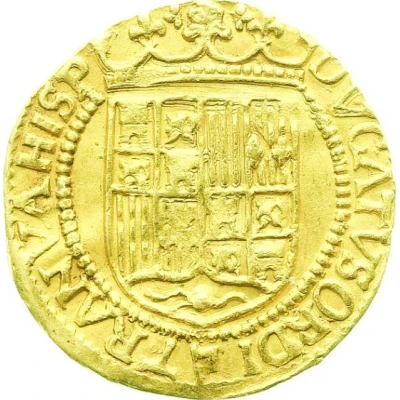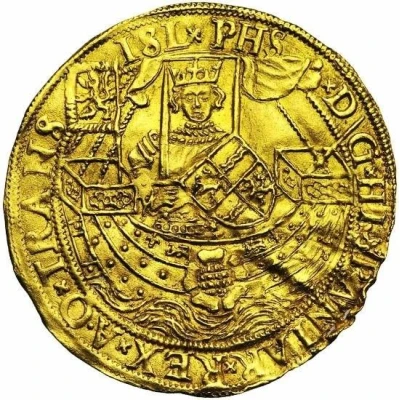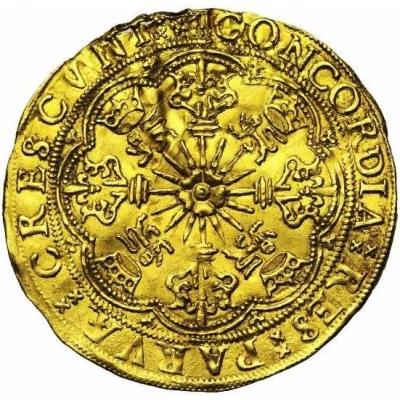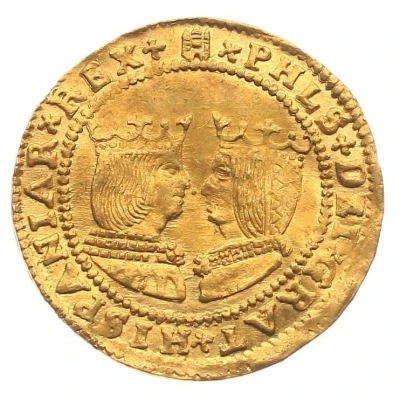
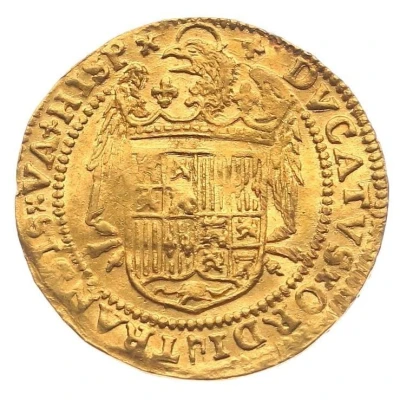

© Heritage Auctions Europe
2 Ducats - Philip II Spanish type ND
| Gold (.983) | 7.02 g | 30 mm |
| Issuer | Lordship of Overijssel (Dutch States) |
|---|---|
| King | Philip II (1556-1598) |
| Type | Standard circulation coin |
| Years | 1582-1593 |
| Value | 2 Ducats = 6 Gulden |
| Currency | Gulden (1506-1581) |
| Composition | Gold (.983) |
| Weight | 7.02 g |
| Diameter | 30 mm |
| Shape | Round |
| Technique | Hammered |
| Orientation | Coin alignment ↑↓ |
| Demonetized | Yes |
| Updated | 2024-10-06 |
| Numista | N#107177 |
|---|---|
| Rarity index | 100% |
Reverse
Crowned arms of Spain, supported by eagle behind, nimbate with head turned left.
Script: Latin
Lettering: + DVCATVS × ORDI × TRANSIS × VA + HISP ×
Unabridged legend: Ducatus ordinum Transisulaniae Cum Valore in Hispaniae
Translation: Ducat of the Province of Overijssel with Value in Spain
Comment
Between 1580 and 1601 almost all the mints of the United Provinces issued ducats and double ducats type of Spanish Catholic Kings.The Overijssel issue is particularly confusing for several reasons:
1. There are many subtypes or variants, employing different combinations of these symbols: city gate, hook, lion, and the Overijssel lion which has waves at its side. There are additional minor punctuation and spelling variants covered to some extent in the two main references (but not here).
2. Delmonte and Van Gelder & Hoc, the two key modern references, assign catalog references to the subtypes differently (Delmonte attributes more subtypes); there are also known variants that do not fit any of their types. Furthermore, Delmonte assigns this coin to Overijssel Province in the Dutch Republic, whereas Van Gelder & Hoc assign them to Spanish Netherlands under Philip II, noting that the departure of Overijssel from Philip's realm did not occur until 1591 (yet, one of their types has a date range 1590-1593).
3. The rarity assignments of Delmonte clearly do not reflect the frequency of known examples in the current market (see end of Comment).
4. Auction houses routinely assign incorrect Delmonte attributions.
5. It is not clear where the coins were minted. Van Gelder and Hoc say that Hasselt was the main mint of Overijssel under Philip until 1581. However the city gate mark used on some types is traditionally assigned to Kampen.
With these comments as background, the Delmonte and GH attributions are as follows, with examples provided to illustrate them:
Delmonte 1043 / GH 261-17b (1590-1593), main photos:
Obverse: (city gate) PHLS DEI GRAT HISPANIAR REX
Reverse: DVCATVS ODRI (hook) TRANSIS VAL HISP
Delmonte 1044 / GH 261-17b (1590-1593)
Obverse: (hook) PHLS DEI GRAT (city gate) HISPANIAR REX
Reverse: DVCATVS ORDI (hook) TRANSIS VA HISP
© Heritage Auctions Europe
Delmonte 1045 / GH 261-17a (1582-1589)
Obverse: PHLS DEI GRAT (city gate) HISPANIAR REX
Reverse: DVCATVS ORDI (lion) TRANSISS VAL HISP
© Fritz Rudolph Kunker
Delmonte 1046 / GH 261-17a? (1582-1589)
Obverse: PHLS DEI GRAT (city gate) HISPANIAR REX
Reverse: DUCATVS ORDI (Overijssel lion) TRANSISS VAL HISP
© Stacks Bowers
Variant of Delmonte 1046 with (city gate) PHLS DEI GRAT HISPANIAR REX obverse:
© Heritage Auctions Europe
Variant of Delmonte 1046 with (star) PHLS DEI GRAT HISPANIAR REX obverse:
© Jean Elsen et Ses Fils
Observations on Rarity.
From a search on acsearch.info conducted 2 July, 2023 using the search term Overijssel and the Delmonte number (1043, then 1044, etc.), these observations were made:
- Delmonte 1043
Eight sales were found, four of which had been mis-attrbuted as other subtypes.
Delmonte 1044
Three sales were found, but it was the some coin being re-sold three times.
Delmonte 1045
One sale was found, of a coin mis-attributed as Delmonte 1046.
Delmonte 1046
Six sales were found, one of which had been mis-attributed
These findings suggest that the Delmonte rarity ratings for 1045 (R1) and 1046 (R4) are possibly mistaken and should be switched.
Interesting fact
One interesting fact about this coin is that it was minted during a time of great turmoil in Europe, specifically during the Eighty Years' War (1568-1648) between the Dutch Republic and Spain. Despite the conflict, the coin still bears the image of Philip II of Spain, indicating the complex political and economic ties between the Dutch States and Spain during this period.
